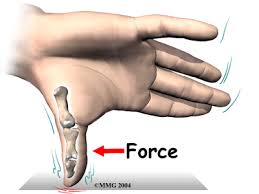Ligament Injuries to the Thumb
Ligaments are soft tissue structures that attach bones together, and in so doing support the join or joint between these bones. The term ligament sprain means that the ligament fibres are disrupted and is synonymous with ligament tear.
Ligaments are soft tissue structures that attach bones together, and in so doing support the join or joint between these bones. The term ligament sprain means that the ligament fibres are disrupted and is synonymous with ligament tear.
In the thumb most of these injuries occur at the metacarpophalangeal joint (or MCP joint). The ligaments that support this joint are the ulnar and radial collateral ligaments. These ligaments can either sustain a partial tear/sprain or sustain a full tear/rupture.
It is important that this injury is diagnosed correctly and management is correct, as long term problems can result from incorrect management. Injuries to the ulnar collateral ligament are commonly referred to as ‘gamekeeper’s or skier’s thumb’, shown in the image below.
Clinical features
- Pain will radiate around the base of the thumb.
- There is usually swelling around the thumb and into the palm if it is a higher grade injury.
- There may be bruising.
- Patient may report a popping feeling when the injury occurs
- It is often quite tender to touch at the base of the thumb
- The joint may appear somewhat deformed, particularly when moved
Diagnosis
Clinical examination will usually alert to suspicion of this injury. Certain x-ray views including stress x-rays may be useful in assessing the ligament.
Treatment
Non-surgical (conservative) management is considered for low grade injuries. Higher grade injuries and those involving fractures always require review from an orthopaedic specialist.
Conservative management is used for partial tears/sprains and will usually include the following:
- Activity Modification/Rest – A period of activity modification is recommended to rest the injured area.
- Immobilisation – The thumb can be braced or supported with tape
- Strengthening – A Physiotherapist prescribed and guided strengthening program is required to help restore normal function to the thumb and hand
Recovery (this is a general guide only)
- Mild – 1-4 weeks
- Moderate – 4-12 weeks
- Severe – Will require review with a hand specialist.

